International Marketing Report: Wendy's Expansion into Foreign Markets
VerifiedAdded on 2022/09/30
|14
|2991
|25
Report
AI Summary
This report provides a comprehensive analysis of Wendy's international marketing strategy, focusing on the challenges and opportunities associated with expanding into foreign markets. It identifies key issues such as social, economic, competitive, legal, and human resource factors that Wendy's must consider. The report then examines the necessary changes to the marketing mix elements, including product adaptation, pricing strategies, distribution channels, and promotional approaches. Furthermore, it recommends India as the most promising foreign market for Wendy's, supported by market data and strategic rationale. The report also suggests a transnational strategy, combining global brand consistency with local market responsiveness. Finally, it advocates for a high level of international expansion with dedicated foreign subsidiaries and production facilities to ensure competitive positioning and maximize return on investment. The report emphasizes the importance of adapting to local market conditions while maintaining a strong brand identity, ultimately aiming to guide Wendy's towards successful international expansion.
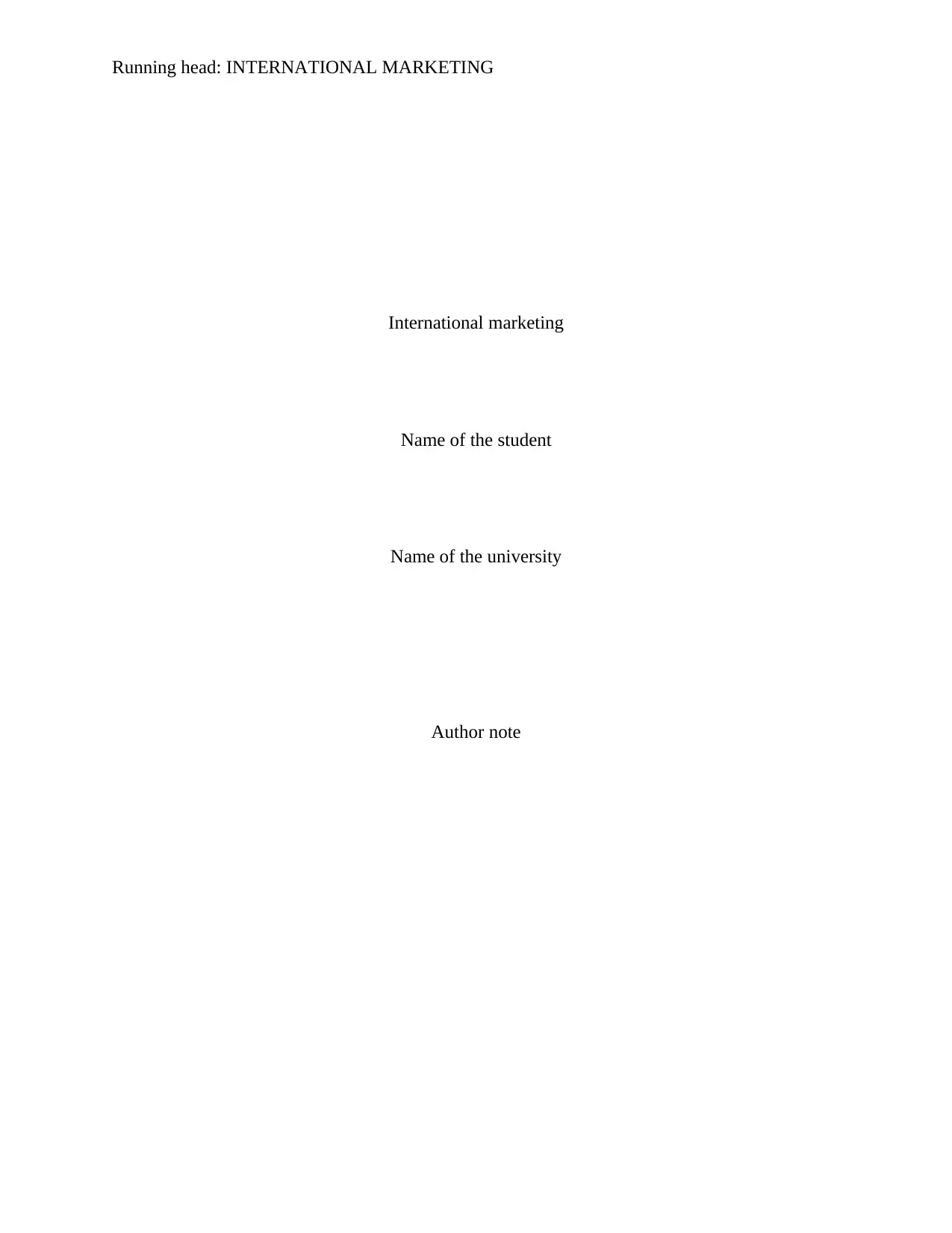
Running head: INTERNATIONAL MARKETING
International marketing
Name of the student
Name of the university
Author note
International marketing
Name of the student
Name of the university
Author note
Paraphrase This Document
Need a fresh take? Get an instant paraphrase of this document with our AI Paraphraser
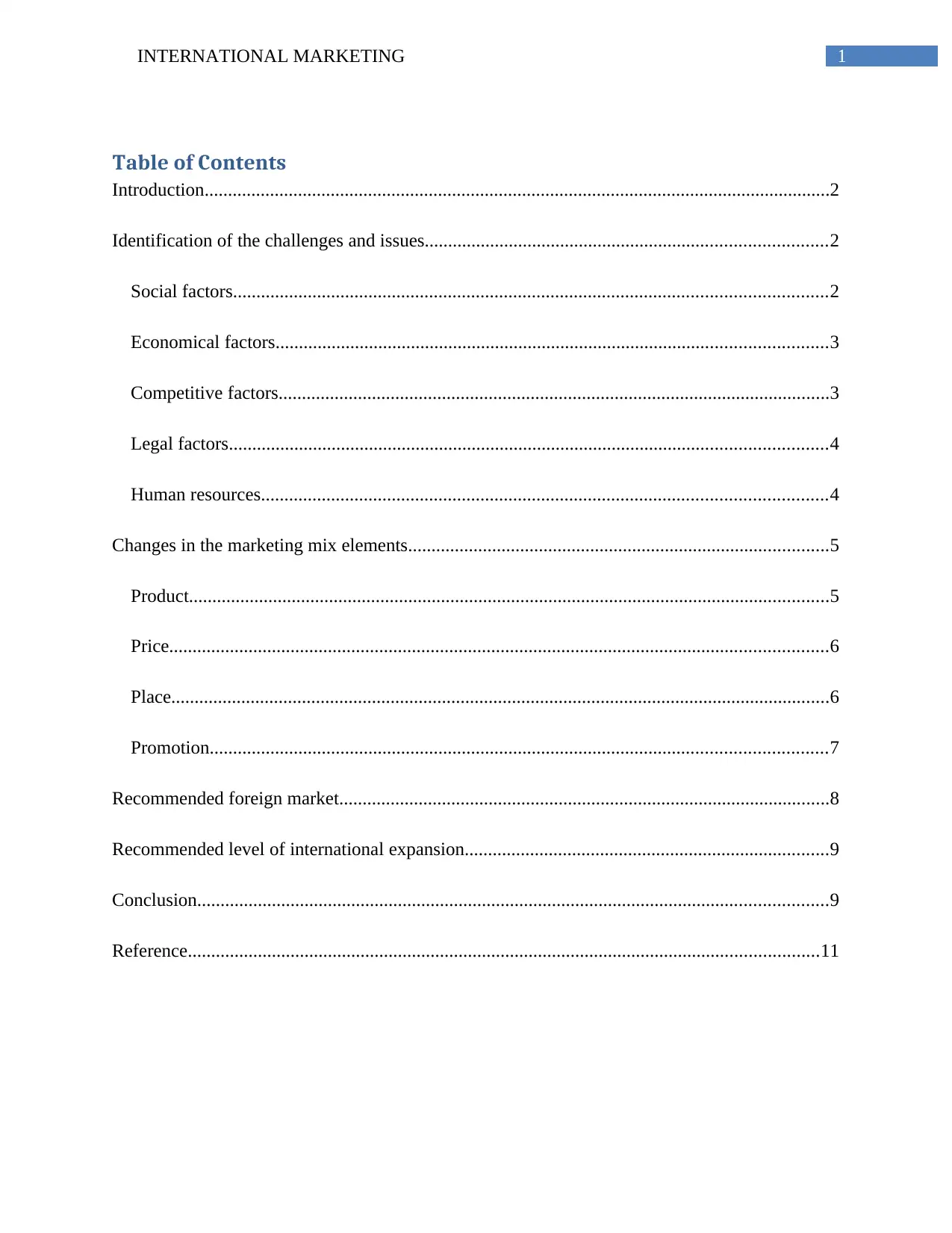
1INTERNATIONAL MARKETING
Table of Contents
Introduction......................................................................................................................................2
Identification of the challenges and issues......................................................................................2
Social factors...............................................................................................................................2
Economical factors......................................................................................................................3
Competitive factors......................................................................................................................3
Legal factors................................................................................................................................4
Human resources.........................................................................................................................4
Changes in the marketing mix elements..........................................................................................5
Product.........................................................................................................................................5
Price.............................................................................................................................................6
Place.............................................................................................................................................6
Promotion....................................................................................................................................7
Recommended foreign market.........................................................................................................8
Recommended level of international expansion..............................................................................9
Conclusion.......................................................................................................................................9
Reference.......................................................................................................................................11
Table of Contents
Introduction......................................................................................................................................2
Identification of the challenges and issues......................................................................................2
Social factors...............................................................................................................................2
Economical factors......................................................................................................................3
Competitive factors......................................................................................................................3
Legal factors................................................................................................................................4
Human resources.........................................................................................................................4
Changes in the marketing mix elements..........................................................................................5
Product.........................................................................................................................................5
Price.............................................................................................................................................6
Place.............................................................................................................................................6
Promotion....................................................................................................................................7
Recommended foreign market.........................................................................................................8
Recommended level of international expansion..............................................................................9
Conclusion.......................................................................................................................................9
Reference.......................................................................................................................................11
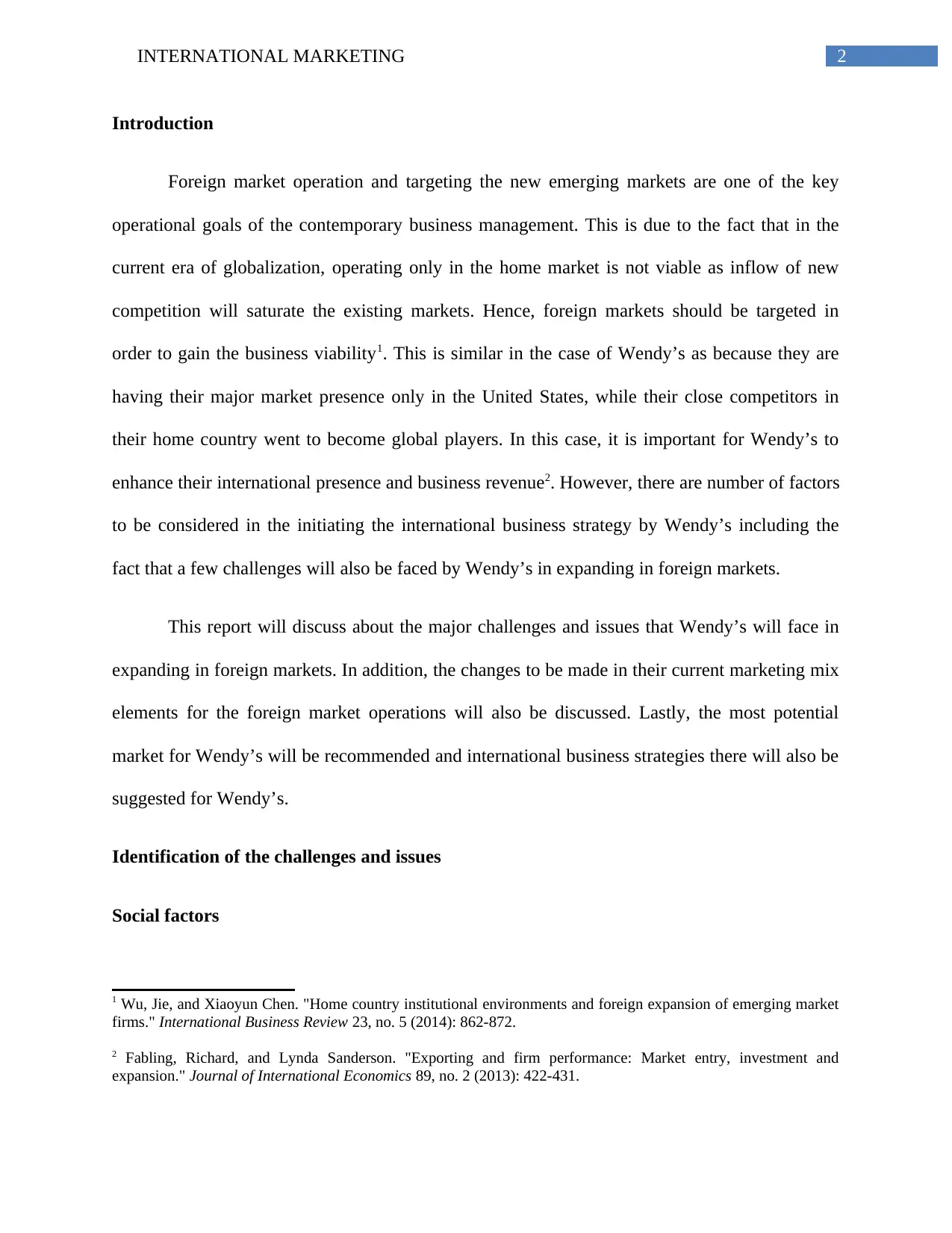
2INTERNATIONAL MARKETING
Introduction
Foreign market operation and targeting the new emerging markets are one of the key
operational goals of the contemporary business management. This is due to the fact that in the
current era of globalization, operating only in the home market is not viable as inflow of new
competition will saturate the existing markets. Hence, foreign markets should be targeted in
order to gain the business viability1. This is similar in the case of Wendy’s as because they are
having their major market presence only in the United States, while their close competitors in
their home country went to become global players. In this case, it is important for Wendy’s to
enhance their international presence and business revenue2. However, there are number of factors
to be considered in the initiating the international business strategy by Wendy’s including the
fact that a few challenges will also be faced by Wendy’s in expanding in foreign markets.
This report will discuss about the major challenges and issues that Wendy’s will face in
expanding in foreign markets. In addition, the changes to be made in their current marketing mix
elements for the foreign market operations will also be discussed. Lastly, the most potential
market for Wendy’s will be recommended and international business strategies there will also be
suggested for Wendy’s.
Identification of the challenges and issues
Social factors
1 Wu, Jie, and Xiaoyun Chen. "Home country institutional environments and foreign expansion of emerging market
firms." International Business Review 23, no. 5 (2014): 862-872.
2 Fabling, Richard, and Lynda Sanderson. "Exporting and firm performance: Market entry, investment and
expansion." Journal of International Economics 89, no. 2 (2013): 422-431.
Introduction
Foreign market operation and targeting the new emerging markets are one of the key
operational goals of the contemporary business management. This is due to the fact that in the
current era of globalization, operating only in the home market is not viable as inflow of new
competition will saturate the existing markets. Hence, foreign markets should be targeted in
order to gain the business viability1. This is similar in the case of Wendy’s as because they are
having their major market presence only in the United States, while their close competitors in
their home country went to become global players. In this case, it is important for Wendy’s to
enhance their international presence and business revenue2. However, there are number of factors
to be considered in the initiating the international business strategy by Wendy’s including the
fact that a few challenges will also be faced by Wendy’s in expanding in foreign markets.
This report will discuss about the major challenges and issues that Wendy’s will face in
expanding in foreign markets. In addition, the changes to be made in their current marketing mix
elements for the foreign market operations will also be discussed. Lastly, the most potential
market for Wendy’s will be recommended and international business strategies there will also be
suggested for Wendy’s.
Identification of the challenges and issues
Social factors
1 Wu, Jie, and Xiaoyun Chen. "Home country institutional environments and foreign expansion of emerging market
firms." International Business Review 23, no. 5 (2014): 862-872.
2 Fabling, Richard, and Lynda Sanderson. "Exporting and firm performance: Market entry, investment and
expansion." Journal of International Economics 89, no. 2 (2013): 422-431.
⊘ This is a preview!⊘
Do you want full access?
Subscribe today to unlock all pages.

Trusted by 1+ million students worldwide
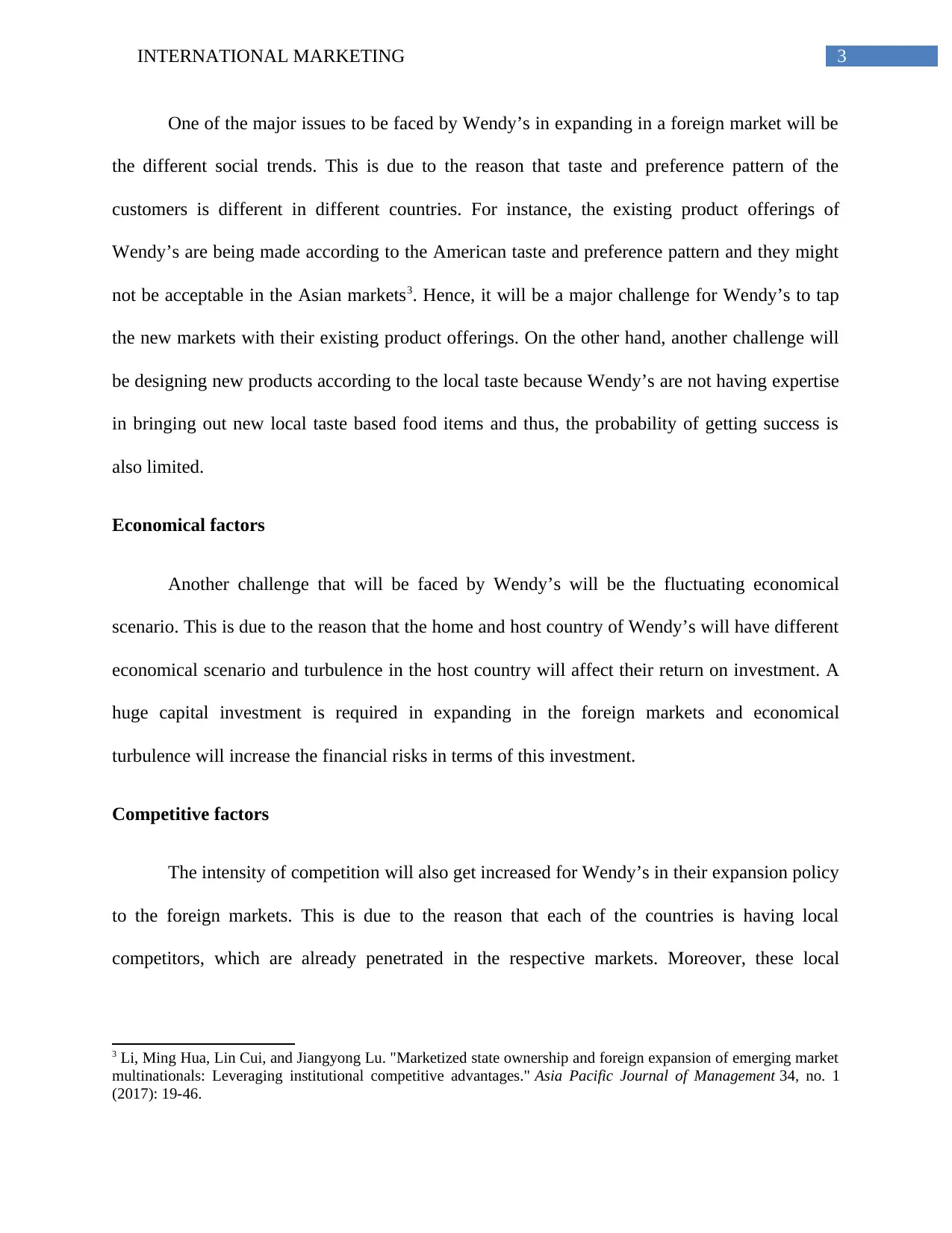
3INTERNATIONAL MARKETING
One of the major issues to be faced by Wendy’s in expanding in a foreign market will be
the different social trends. This is due to the reason that taste and preference pattern of the
customers is different in different countries. For instance, the existing product offerings of
Wendy’s are being made according to the American taste and preference pattern and they might
not be acceptable in the Asian markets3. Hence, it will be a major challenge for Wendy’s to tap
the new markets with their existing product offerings. On the other hand, another challenge will
be designing new products according to the local taste because Wendy’s are not having expertise
in bringing out new local taste based food items and thus, the probability of getting success is
also limited.
Economical factors
Another challenge that will be faced by Wendy’s will be the fluctuating economical
scenario. This is due to the reason that the home and host country of Wendy’s will have different
economical scenario and turbulence in the host country will affect their return on investment. A
huge capital investment is required in expanding in the foreign markets and economical
turbulence will increase the financial risks in terms of this investment.
Competitive factors
The intensity of competition will also get increased for Wendy’s in their expansion policy
to the foreign markets. This is due to the reason that each of the countries is having local
competitors, which are already penetrated in the respective markets. Moreover, these local
3 Li, Ming Hua, Lin Cui, and Jiangyong Lu. "Marketized state ownership and foreign expansion of emerging market
multinationals: Leveraging institutional competitive advantages." Asia Pacific Journal of Management 34, no. 1
(2017): 19-46.
One of the major issues to be faced by Wendy’s in expanding in a foreign market will be
the different social trends. This is due to the reason that taste and preference pattern of the
customers is different in different countries. For instance, the existing product offerings of
Wendy’s are being made according to the American taste and preference pattern and they might
not be acceptable in the Asian markets3. Hence, it will be a major challenge for Wendy’s to tap
the new markets with their existing product offerings. On the other hand, another challenge will
be designing new products according to the local taste because Wendy’s are not having expertise
in bringing out new local taste based food items and thus, the probability of getting success is
also limited.
Economical factors
Another challenge that will be faced by Wendy’s will be the fluctuating economical
scenario. This is due to the reason that the home and host country of Wendy’s will have different
economical scenario and turbulence in the host country will affect their return on investment. A
huge capital investment is required in expanding in the foreign markets and economical
turbulence will increase the financial risks in terms of this investment.
Competitive factors
The intensity of competition will also get increased for Wendy’s in their expansion policy
to the foreign markets. This is due to the reason that each of the countries is having local
competitors, which are already penetrated in the respective markets. Moreover, these local
3 Li, Ming Hua, Lin Cui, and Jiangyong Lu. "Marketized state ownership and foreign expansion of emerging market
multinationals: Leveraging institutional competitive advantages." Asia Pacific Journal of Management 34, no. 1
(2017): 19-46.
Paraphrase This Document
Need a fresh take? Get an instant paraphrase of this document with our AI Paraphraser
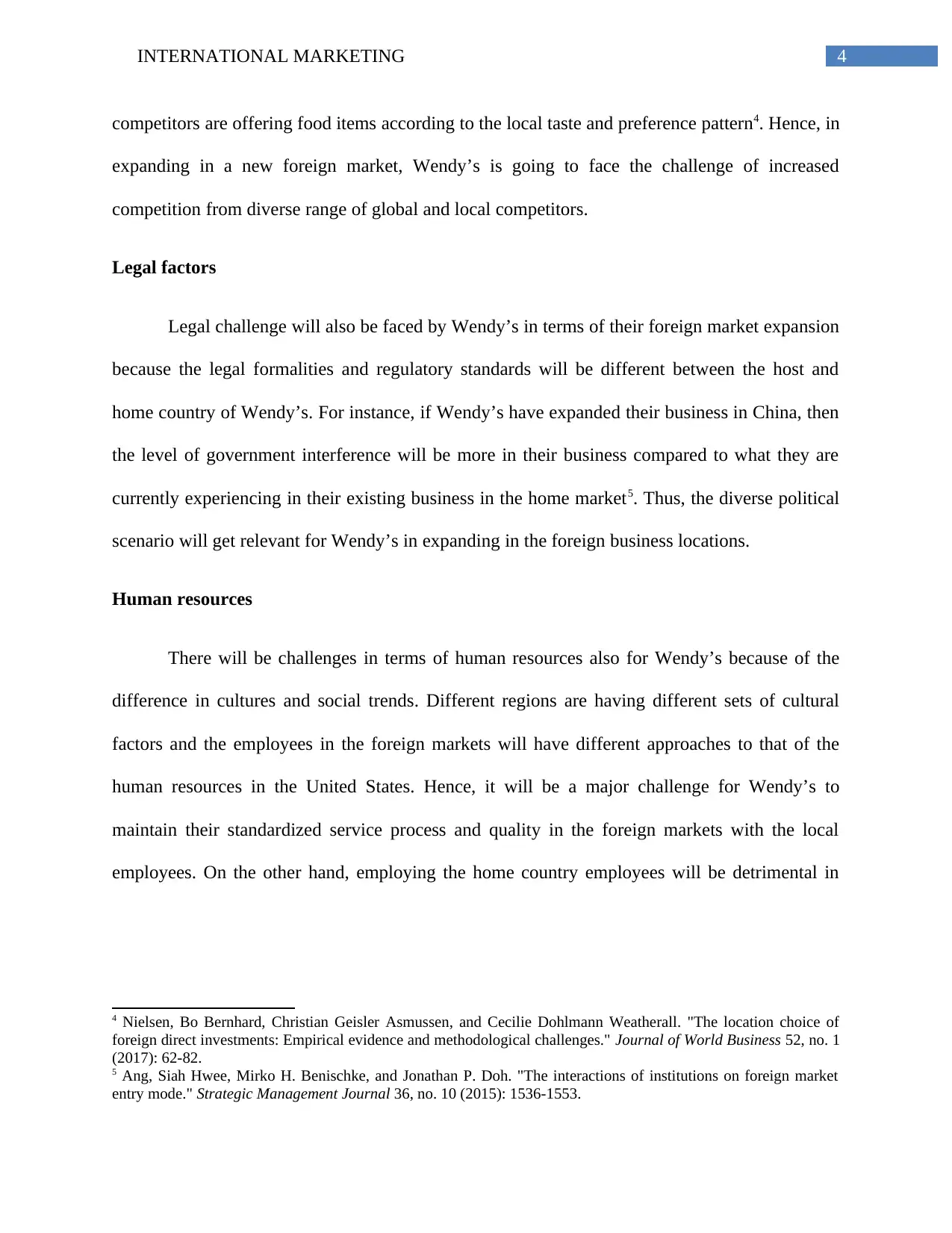
4INTERNATIONAL MARKETING
competitors are offering food items according to the local taste and preference pattern4. Hence, in
expanding in a new foreign market, Wendy’s is going to face the challenge of increased
competition from diverse range of global and local competitors.
Legal factors
Legal challenge will also be faced by Wendy’s in terms of their foreign market expansion
because the legal formalities and regulatory standards will be different between the host and
home country of Wendy’s. For instance, if Wendy’s have expanded their business in China, then
the level of government interference will be more in their business compared to what they are
currently experiencing in their existing business in the home market5. Thus, the diverse political
scenario will get relevant for Wendy’s in expanding in the foreign business locations.
Human resources
There will be challenges in terms of human resources also for Wendy’s because of the
difference in cultures and social trends. Different regions are having different sets of cultural
factors and the employees in the foreign markets will have different approaches to that of the
human resources in the United States. Hence, it will be a major challenge for Wendy’s to
maintain their standardized service process and quality in the foreign markets with the local
employees. On the other hand, employing the home country employees will be detrimental in
4 Nielsen, Bo Bernhard, Christian Geisler Asmussen, and Cecilie Dohlmann Weatherall. "The location choice of
foreign direct investments: Empirical evidence and methodological challenges." Journal of World Business 52, no. 1
(2017): 62-82.
5 Ang, Siah Hwee, Mirko H. Benischke, and Jonathan P. Doh. "The interactions of institutions on foreign market
entry mode." Strategic Management Journal 36, no. 10 (2015): 1536-1553.
competitors are offering food items according to the local taste and preference pattern4. Hence, in
expanding in a new foreign market, Wendy’s is going to face the challenge of increased
competition from diverse range of global and local competitors.
Legal factors
Legal challenge will also be faced by Wendy’s in terms of their foreign market expansion
because the legal formalities and regulatory standards will be different between the host and
home country of Wendy’s. For instance, if Wendy’s have expanded their business in China, then
the level of government interference will be more in their business compared to what they are
currently experiencing in their existing business in the home market5. Thus, the diverse political
scenario will get relevant for Wendy’s in expanding in the foreign business locations.
Human resources
There will be challenges in terms of human resources also for Wendy’s because of the
difference in cultures and social trends. Different regions are having different sets of cultural
factors and the employees in the foreign markets will have different approaches to that of the
human resources in the United States. Hence, it will be a major challenge for Wendy’s to
maintain their standardized service process and quality in the foreign markets with the local
employees. On the other hand, employing the home country employees will be detrimental in
4 Nielsen, Bo Bernhard, Christian Geisler Asmussen, and Cecilie Dohlmann Weatherall. "The location choice of
foreign direct investments: Empirical evidence and methodological challenges." Journal of World Business 52, no. 1
(2017): 62-82.
5 Ang, Siah Hwee, Mirko H. Benischke, and Jonathan P. Doh. "The interactions of institutions on foreign market
entry mode." Strategic Management Journal 36, no. 10 (2015): 1536-1553.
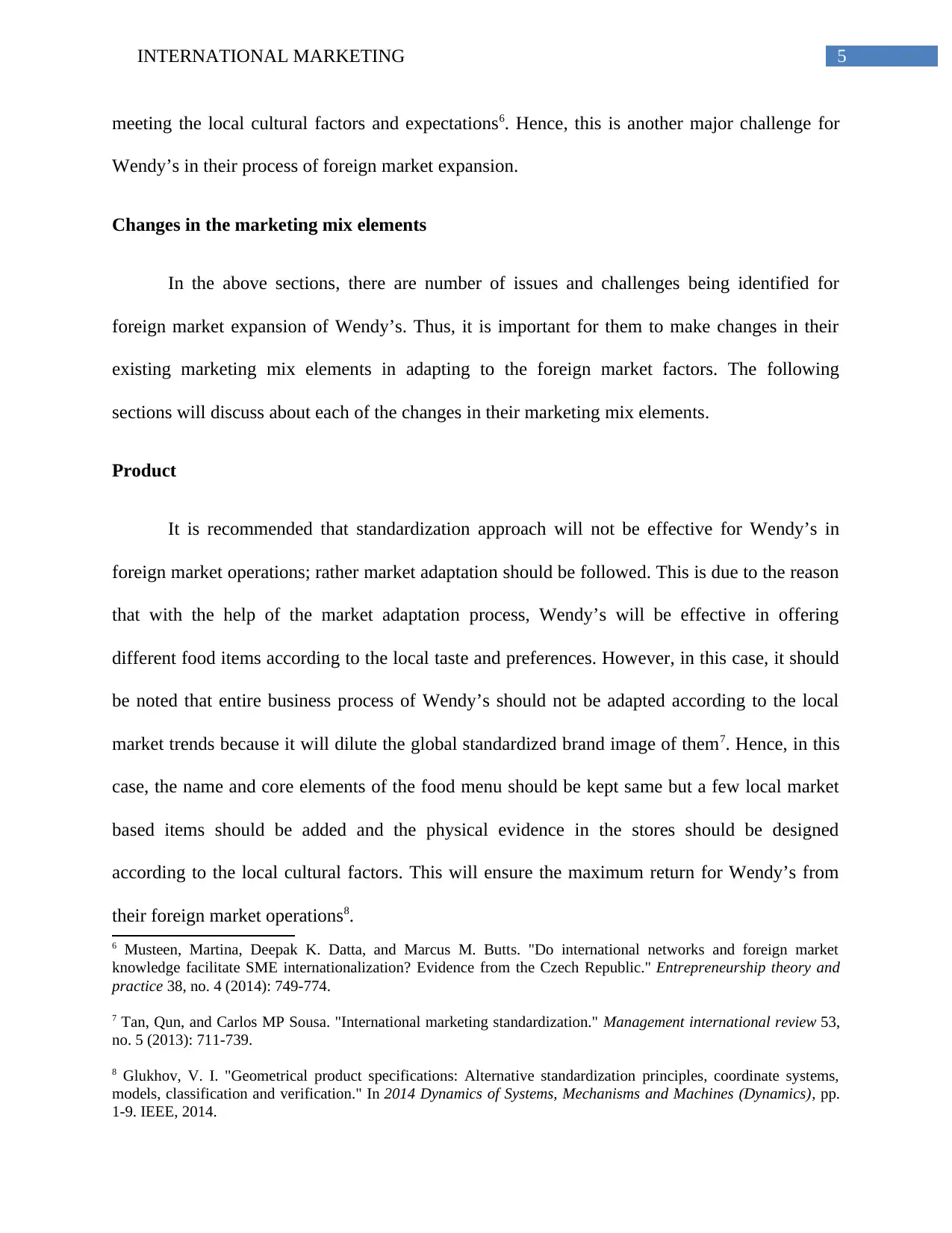
5INTERNATIONAL MARKETING
meeting the local cultural factors and expectations6. Hence, this is another major challenge for
Wendy’s in their process of foreign market expansion.
Changes in the marketing mix elements
In the above sections, there are number of issues and challenges being identified for
foreign market expansion of Wendy’s. Thus, it is important for them to make changes in their
existing marketing mix elements in adapting to the foreign market factors. The following
sections will discuss about each of the changes in their marketing mix elements.
Product
It is recommended that standardization approach will not be effective for Wendy’s in
foreign market operations; rather market adaptation should be followed. This is due to the reason
that with the help of the market adaptation process, Wendy’s will be effective in offering
different food items according to the local taste and preferences. However, in this case, it should
be noted that entire business process of Wendy’s should not be adapted according to the local
market trends because it will dilute the global standardized brand image of them7. Hence, in this
case, the name and core elements of the food menu should be kept same but a few local market
based items should be added and the physical evidence in the stores should be designed
according to the local cultural factors. This will ensure the maximum return for Wendy’s from
their foreign market operations8.
6 Musteen, Martina, Deepak K. Datta, and Marcus M. Butts. "Do international networks and foreign market
knowledge facilitate SME internationalization? Evidence from the Czech Republic." Entrepreneurship theory and
practice 38, no. 4 (2014): 749-774.
7 Tan, Qun, and Carlos MP Sousa. "International marketing standardization." Management international review 53,
no. 5 (2013): 711-739.
8 Glukhov, V. I. "Geometrical product specifications: Alternative standardization principles, coordinate systems,
models, classification and verification." In 2014 Dynamics of Systems, Mechanisms and Machines (Dynamics), pp.
1-9. IEEE, 2014.
meeting the local cultural factors and expectations6. Hence, this is another major challenge for
Wendy’s in their process of foreign market expansion.
Changes in the marketing mix elements
In the above sections, there are number of issues and challenges being identified for
foreign market expansion of Wendy’s. Thus, it is important for them to make changes in their
existing marketing mix elements in adapting to the foreign market factors. The following
sections will discuss about each of the changes in their marketing mix elements.
Product
It is recommended that standardization approach will not be effective for Wendy’s in
foreign market operations; rather market adaptation should be followed. This is due to the reason
that with the help of the market adaptation process, Wendy’s will be effective in offering
different food items according to the local taste and preferences. However, in this case, it should
be noted that entire business process of Wendy’s should not be adapted according to the local
market trends because it will dilute the global standardized brand image of them7. Hence, in this
case, the name and core elements of the food menu should be kept same but a few local market
based items should be added and the physical evidence in the stores should be designed
according to the local cultural factors. This will ensure the maximum return for Wendy’s from
their foreign market operations8.
6 Musteen, Martina, Deepak K. Datta, and Marcus M. Butts. "Do international networks and foreign market
knowledge facilitate SME internationalization? Evidence from the Czech Republic." Entrepreneurship theory and
practice 38, no. 4 (2014): 749-774.
7 Tan, Qun, and Carlos MP Sousa. "International marketing standardization." Management international review 53,
no. 5 (2013): 711-739.
8 Glukhov, V. I. "Geometrical product specifications: Alternative standardization principles, coordinate systems,
models, classification and verification." In 2014 Dynamics of Systems, Mechanisms and Machines (Dynamics), pp.
1-9. IEEE, 2014.
⊘ This is a preview!⊘
Do you want full access?
Subscribe today to unlock all pages.

Trusted by 1+ million students worldwide
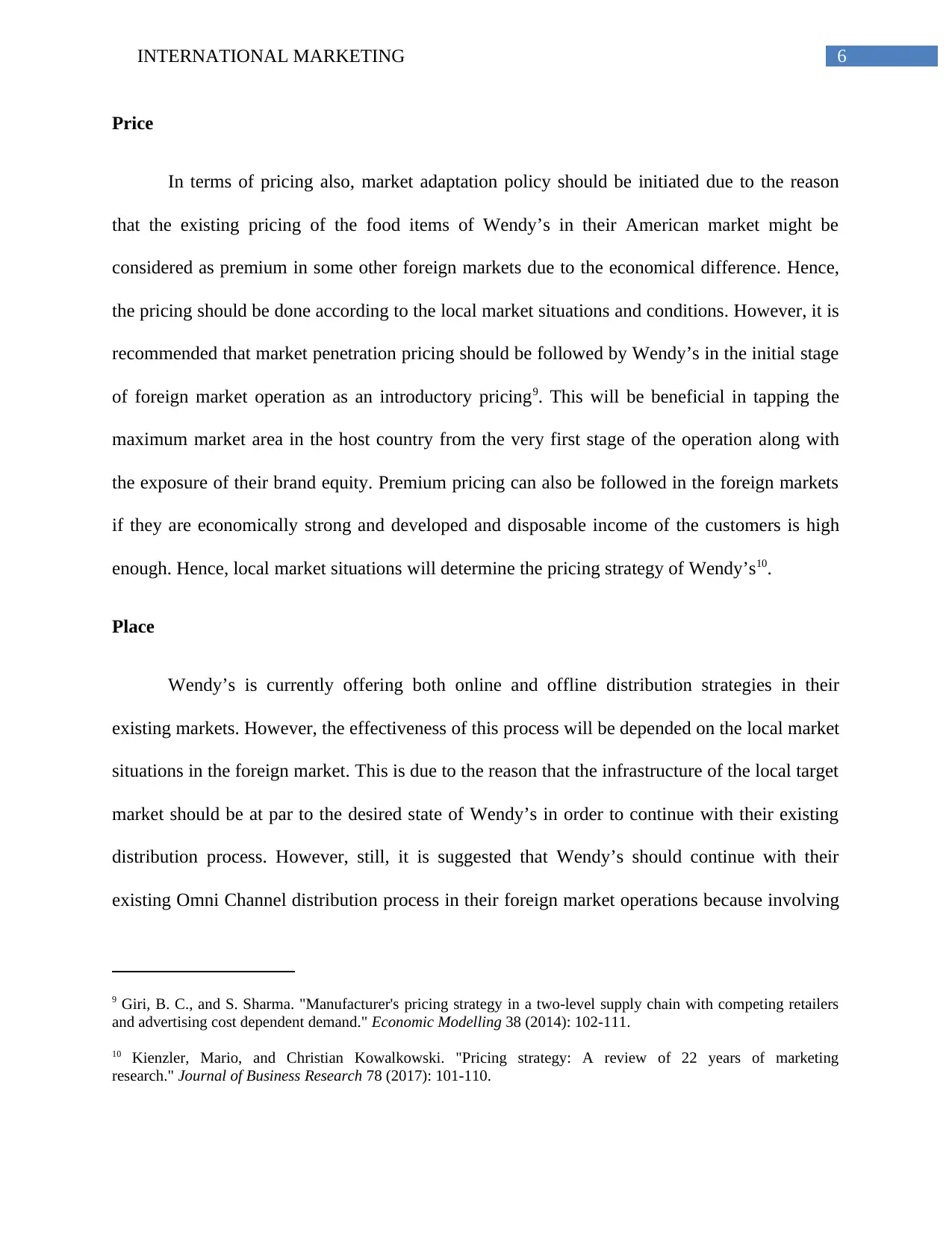
6INTERNATIONAL MARKETING
Price
In terms of pricing also, market adaptation policy should be initiated due to the reason
that the existing pricing of the food items of Wendy’s in their American market might be
considered as premium in some other foreign markets due to the economical difference. Hence,
the pricing should be done according to the local market situations and conditions. However, it is
recommended that market penetration pricing should be followed by Wendy’s in the initial stage
of foreign market operation as an introductory pricing9. This will be beneficial in tapping the
maximum market area in the host country from the very first stage of the operation along with
the exposure of their brand equity. Premium pricing can also be followed in the foreign markets
if they are economically strong and developed and disposable income of the customers is high
enough. Hence, local market situations will determine the pricing strategy of Wendy’s10.
Place
Wendy’s is currently offering both online and offline distribution strategies in their
existing markets. However, the effectiveness of this process will be depended on the local market
situations in the foreign market. This is due to the reason that the infrastructure of the local target
market should be at par to the desired state of Wendy’s in order to continue with their existing
distribution process. However, still, it is suggested that Wendy’s should continue with their
existing Omni Channel distribution process in their foreign market operations because involving
9 Giri, B. C., and S. Sharma. "Manufacturer's pricing strategy in a two-level supply chain with competing retailers
and advertising cost dependent demand." Economic Modelling 38 (2014): 102-111.
10 Kienzler, Mario, and Christian Kowalkowski. "Pricing strategy: A review of 22 years of marketing
research." Journal of Business Research 78 (2017): 101-110.
Price
In terms of pricing also, market adaptation policy should be initiated due to the reason
that the existing pricing of the food items of Wendy’s in their American market might be
considered as premium in some other foreign markets due to the economical difference. Hence,
the pricing should be done according to the local market situations and conditions. However, it is
recommended that market penetration pricing should be followed by Wendy’s in the initial stage
of foreign market operation as an introductory pricing9. This will be beneficial in tapping the
maximum market area in the host country from the very first stage of the operation along with
the exposure of their brand equity. Premium pricing can also be followed in the foreign markets
if they are economically strong and developed and disposable income of the customers is high
enough. Hence, local market situations will determine the pricing strategy of Wendy’s10.
Place
Wendy’s is currently offering both online and offline distribution strategies in their
existing markets. However, the effectiveness of this process will be depended on the local market
situations in the foreign market. This is due to the reason that the infrastructure of the local target
market should be at par to the desired state of Wendy’s in order to continue with their existing
distribution process. However, still, it is suggested that Wendy’s should continue with their
existing Omni Channel distribution process in their foreign market operations because involving
9 Giri, B. C., and S. Sharma. "Manufacturer's pricing strategy in a two-level supply chain with competing retailers
and advertising cost dependent demand." Economic Modelling 38 (2014): 102-111.
10 Kienzler, Mario, and Christian Kowalkowski. "Pricing strategy: A review of 22 years of marketing
research." Journal of Business Research 78 (2017): 101-110.
Paraphrase This Document
Need a fresh take? Get an instant paraphrase of this document with our AI Paraphraser
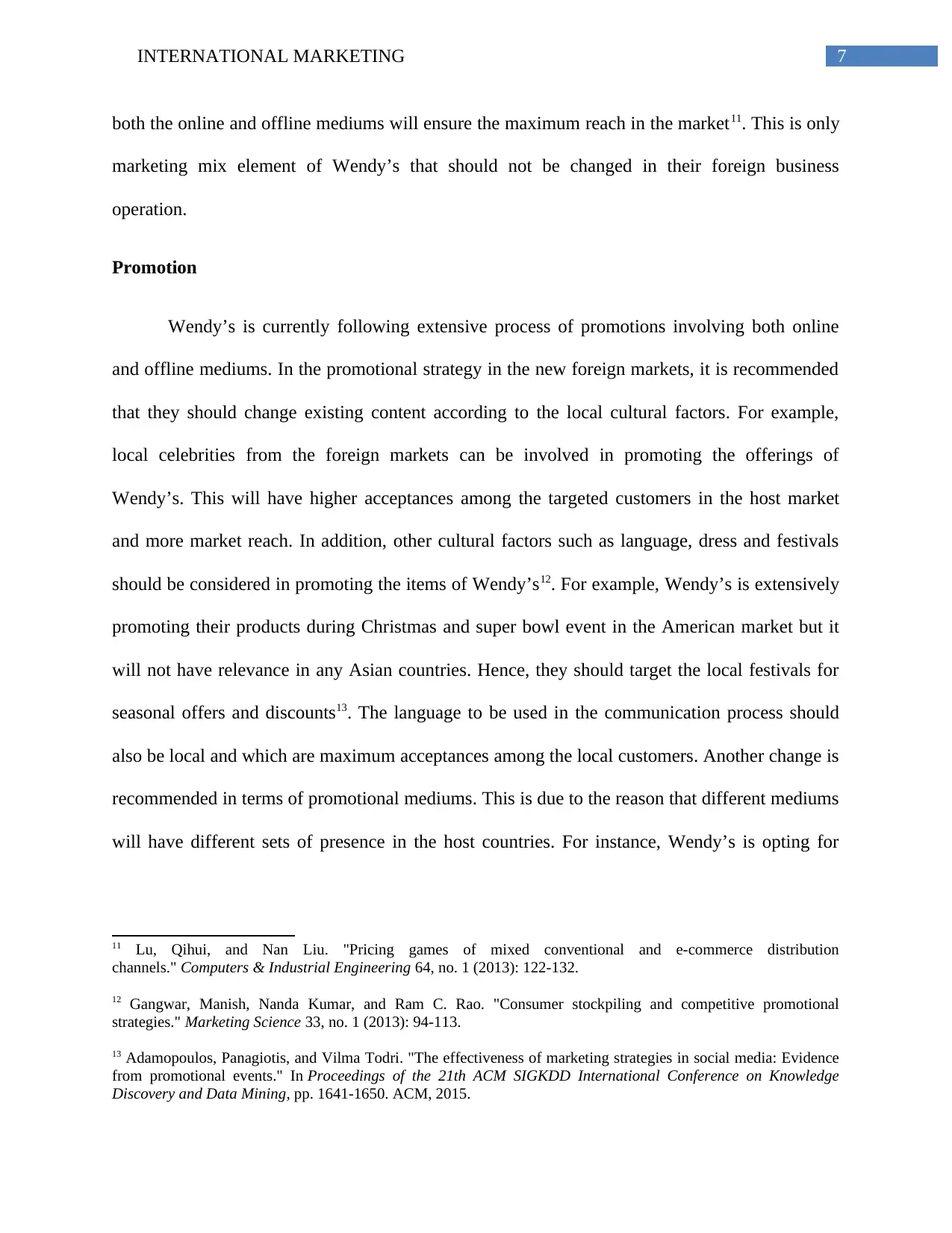
7INTERNATIONAL MARKETING
both the online and offline mediums will ensure the maximum reach in the market11. This is only
marketing mix element of Wendy’s that should not be changed in their foreign business
operation.
Promotion
Wendy’s is currently following extensive process of promotions involving both online
and offline mediums. In the promotional strategy in the new foreign markets, it is recommended
that they should change existing content according to the local cultural factors. For example,
local celebrities from the foreign markets can be involved in promoting the offerings of
Wendy’s. This will have higher acceptances among the targeted customers in the host market
and more market reach. In addition, other cultural factors such as language, dress and festivals
should be considered in promoting the items of Wendy’s12. For example, Wendy’s is extensively
promoting their products during Christmas and super bowl event in the American market but it
will not have relevance in any Asian countries. Hence, they should target the local festivals for
seasonal offers and discounts13. The language to be used in the communication process should
also be local and which are maximum acceptances among the local customers. Another change is
recommended in terms of promotional mediums. This is due to the reason that different mediums
will have different sets of presence in the host countries. For instance, Wendy’s is opting for
11 Lu, Qihui, and Nan Liu. "Pricing games of mixed conventional and e-commerce distribution
channels." Computers & Industrial Engineering 64, no. 1 (2013): 122-132.
12 Gangwar, Manish, Nanda Kumar, and Ram C. Rao. "Consumer stockpiling and competitive promotional
strategies." Marketing Science 33, no. 1 (2013): 94-113.
13 Adamopoulos, Panagiotis, and Vilma Todri. "The effectiveness of marketing strategies in social media: Evidence
from promotional events." In Proceedings of the 21th ACM SIGKDD International Conference on Knowledge
Discovery and Data Mining, pp. 1641-1650. ACM, 2015.
both the online and offline mediums will ensure the maximum reach in the market11. This is only
marketing mix element of Wendy’s that should not be changed in their foreign business
operation.
Promotion
Wendy’s is currently following extensive process of promotions involving both online
and offline mediums. In the promotional strategy in the new foreign markets, it is recommended
that they should change existing content according to the local cultural factors. For example,
local celebrities from the foreign markets can be involved in promoting the offerings of
Wendy’s. This will have higher acceptances among the targeted customers in the host market
and more market reach. In addition, other cultural factors such as language, dress and festivals
should be considered in promoting the items of Wendy’s12. For example, Wendy’s is extensively
promoting their products during Christmas and super bowl event in the American market but it
will not have relevance in any Asian countries. Hence, they should target the local festivals for
seasonal offers and discounts13. The language to be used in the communication process should
also be local and which are maximum acceptances among the local customers. Another change is
recommended in terms of promotional mediums. This is due to the reason that different mediums
will have different sets of presence in the host countries. For instance, Wendy’s is opting for
11 Lu, Qihui, and Nan Liu. "Pricing games of mixed conventional and e-commerce distribution
channels." Computers & Industrial Engineering 64, no. 1 (2013): 122-132.
12 Gangwar, Manish, Nanda Kumar, and Ram C. Rao. "Consumer stockpiling and competitive promotional
strategies." Marketing Science 33, no. 1 (2013): 94-113.
13 Adamopoulos, Panagiotis, and Vilma Todri. "The effectiveness of marketing strategies in social media: Evidence
from promotional events." In Proceedings of the 21th ACM SIGKDD International Conference on Knowledge
Discovery and Data Mining, pp. 1641-1650. ACM, 2015.
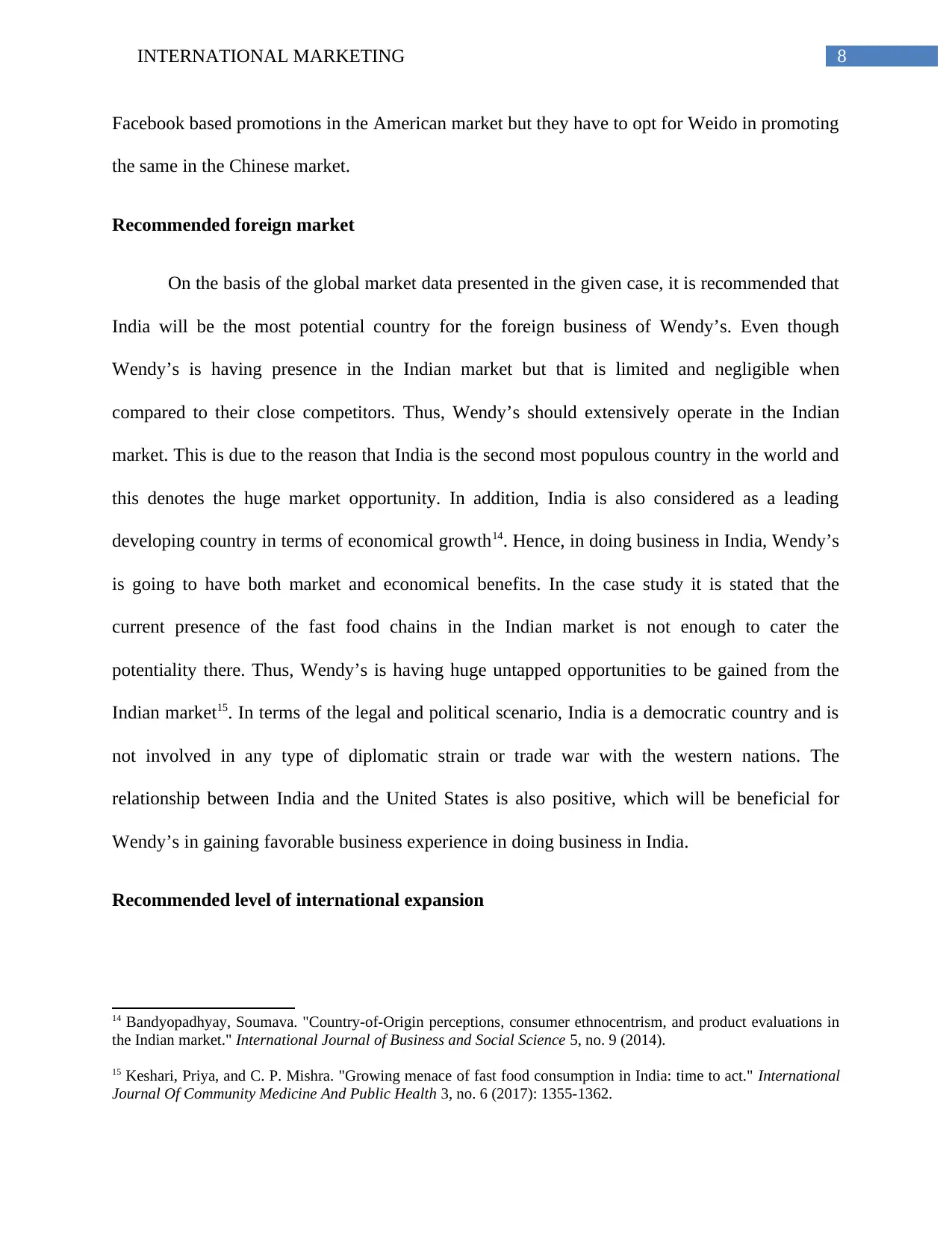
8INTERNATIONAL MARKETING
Facebook based promotions in the American market but they have to opt for Weido in promoting
the same in the Chinese market.
Recommended foreign market
On the basis of the global market data presented in the given case, it is recommended that
India will be the most potential country for the foreign business of Wendy’s. Even though
Wendy’s is having presence in the Indian market but that is limited and negligible when
compared to their close competitors. Thus, Wendy’s should extensively operate in the Indian
market. This is due to the reason that India is the second most populous country in the world and
this denotes the huge market opportunity. In addition, India is also considered as a leading
developing country in terms of economical growth14. Hence, in doing business in India, Wendy’s
is going to have both market and economical benefits. In the case study it is stated that the
current presence of the fast food chains in the Indian market is not enough to cater the
potentiality there. Thus, Wendy’s is having huge untapped opportunities to be gained from the
Indian market15. In terms of the legal and political scenario, India is a democratic country and is
not involved in any type of diplomatic strain or trade war with the western nations. The
relationship between India and the United States is also positive, which will be beneficial for
Wendy’s in gaining favorable business experience in doing business in India.
Recommended level of international expansion
14 Bandyopadhyay, Soumava. "Country-of-Origin perceptions, consumer ethnocentrism, and product evaluations in
the Indian market." International Journal of Business and Social Science 5, no. 9 (2014).
15 Keshari, Priya, and C. P. Mishra. "Growing menace of fast food consumption in India: time to act." International
Journal Of Community Medicine And Public Health 3, no. 6 (2017): 1355-1362.
Facebook based promotions in the American market but they have to opt for Weido in promoting
the same in the Chinese market.
Recommended foreign market
On the basis of the global market data presented in the given case, it is recommended that
India will be the most potential country for the foreign business of Wendy’s. Even though
Wendy’s is having presence in the Indian market but that is limited and negligible when
compared to their close competitors. Thus, Wendy’s should extensively operate in the Indian
market. This is due to the reason that India is the second most populous country in the world and
this denotes the huge market opportunity. In addition, India is also considered as a leading
developing country in terms of economical growth14. Hence, in doing business in India, Wendy’s
is going to have both market and economical benefits. In the case study it is stated that the
current presence of the fast food chains in the Indian market is not enough to cater the
potentiality there. Thus, Wendy’s is having huge untapped opportunities to be gained from the
Indian market15. In terms of the legal and political scenario, India is a democratic country and is
not involved in any type of diplomatic strain or trade war with the western nations. The
relationship between India and the United States is also positive, which will be beneficial for
Wendy’s in gaining favorable business experience in doing business in India.
Recommended level of international expansion
14 Bandyopadhyay, Soumava. "Country-of-Origin perceptions, consumer ethnocentrism, and product evaluations in
the Indian market." International Journal of Business and Social Science 5, no. 9 (2014).
15 Keshari, Priya, and C. P. Mishra. "Growing menace of fast food consumption in India: time to act." International
Journal Of Community Medicine And Public Health 3, no. 6 (2017): 1355-1362.
⊘ This is a preview!⊘
Do you want full access?
Subscribe today to unlock all pages.

Trusted by 1+ million students worldwide
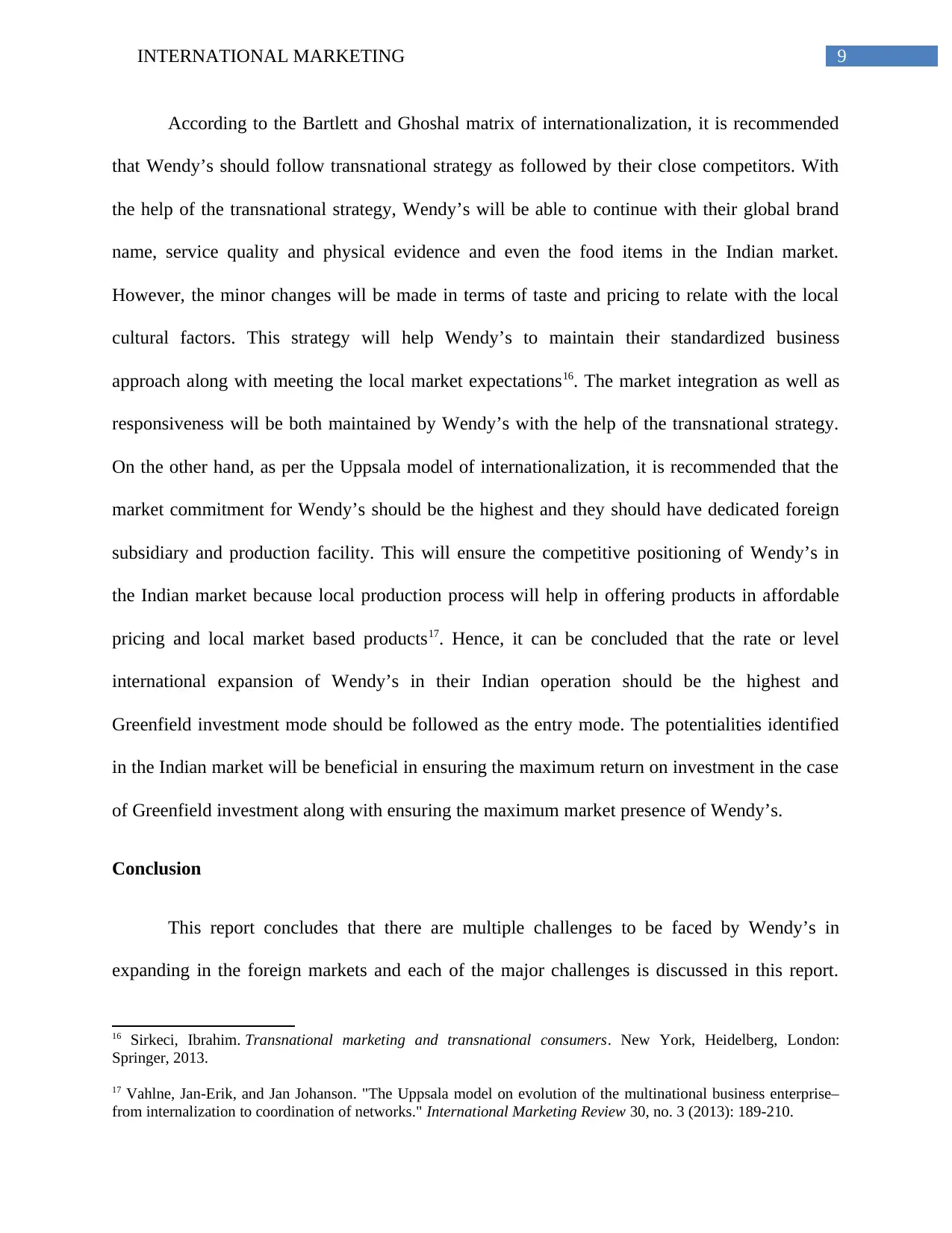
9INTERNATIONAL MARKETING
According to the Bartlett and Ghoshal matrix of internationalization, it is recommended
that Wendy’s should follow transnational strategy as followed by their close competitors. With
the help of the transnational strategy, Wendy’s will be able to continue with their global brand
name, service quality and physical evidence and even the food items in the Indian market.
However, the minor changes will be made in terms of taste and pricing to relate with the local
cultural factors. This strategy will help Wendy’s to maintain their standardized business
approach along with meeting the local market expectations16. The market integration as well as
responsiveness will be both maintained by Wendy’s with the help of the transnational strategy.
On the other hand, as per the Uppsala model of internationalization, it is recommended that the
market commitment for Wendy’s should be the highest and they should have dedicated foreign
subsidiary and production facility. This will ensure the competitive positioning of Wendy’s in
the Indian market because local production process will help in offering products in affordable
pricing and local market based products17. Hence, it can be concluded that the rate or level
international expansion of Wendy’s in their Indian operation should be the highest and
Greenfield investment mode should be followed as the entry mode. The potentialities identified
in the Indian market will be beneficial in ensuring the maximum return on investment in the case
of Greenfield investment along with ensuring the maximum market presence of Wendy’s.
Conclusion
This report concludes that there are multiple challenges to be faced by Wendy’s in
expanding in the foreign markets and each of the major challenges is discussed in this report.
16 Sirkeci, Ibrahim. Transnational marketing and transnational consumers. New York, Heidelberg, London:
Springer, 2013.
17 Vahlne, Jan-Erik, and Jan Johanson. "The Uppsala model on evolution of the multinational business enterprise–
from internalization to coordination of networks." International Marketing Review 30, no. 3 (2013): 189-210.
According to the Bartlett and Ghoshal matrix of internationalization, it is recommended
that Wendy’s should follow transnational strategy as followed by their close competitors. With
the help of the transnational strategy, Wendy’s will be able to continue with their global brand
name, service quality and physical evidence and even the food items in the Indian market.
However, the minor changes will be made in terms of taste and pricing to relate with the local
cultural factors. This strategy will help Wendy’s to maintain their standardized business
approach along with meeting the local market expectations16. The market integration as well as
responsiveness will be both maintained by Wendy’s with the help of the transnational strategy.
On the other hand, as per the Uppsala model of internationalization, it is recommended that the
market commitment for Wendy’s should be the highest and they should have dedicated foreign
subsidiary and production facility. This will ensure the competitive positioning of Wendy’s in
the Indian market because local production process will help in offering products in affordable
pricing and local market based products17. Hence, it can be concluded that the rate or level
international expansion of Wendy’s in their Indian operation should be the highest and
Greenfield investment mode should be followed as the entry mode. The potentialities identified
in the Indian market will be beneficial in ensuring the maximum return on investment in the case
of Greenfield investment along with ensuring the maximum market presence of Wendy’s.
Conclusion
This report concludes that there are multiple challenges to be faced by Wendy’s in
expanding in the foreign markets and each of the major challenges is discussed in this report.
16 Sirkeci, Ibrahim. Transnational marketing and transnational consumers. New York, Heidelberg, London:
Springer, 2013.
17 Vahlne, Jan-Erik, and Jan Johanson. "The Uppsala model on evolution of the multinational business enterprise–
from internalization to coordination of networks." International Marketing Review 30, no. 3 (2013): 189-210.
Paraphrase This Document
Need a fresh take? Get an instant paraphrase of this document with our AI Paraphraser
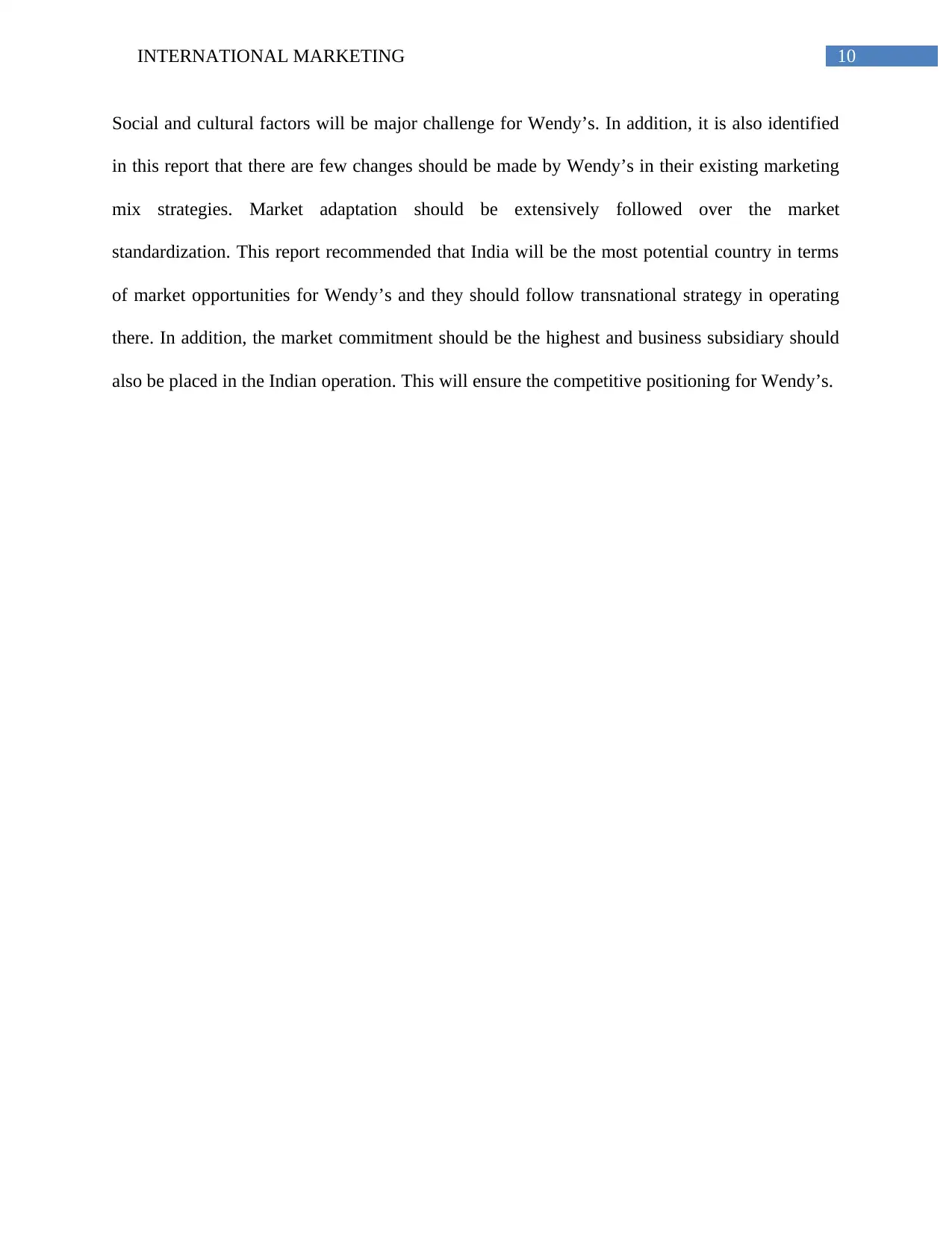
10INTERNATIONAL MARKETING
Social and cultural factors will be major challenge for Wendy’s. In addition, it is also identified
in this report that there are few changes should be made by Wendy’s in their existing marketing
mix strategies. Market adaptation should be extensively followed over the market
standardization. This report recommended that India will be the most potential country in terms
of market opportunities for Wendy’s and they should follow transnational strategy in operating
there. In addition, the market commitment should be the highest and business subsidiary should
also be placed in the Indian operation. This will ensure the competitive positioning for Wendy’s.
Social and cultural factors will be major challenge for Wendy’s. In addition, it is also identified
in this report that there are few changes should be made by Wendy’s in their existing marketing
mix strategies. Market adaptation should be extensively followed over the market
standardization. This report recommended that India will be the most potential country in terms
of market opportunities for Wendy’s and they should follow transnational strategy in operating
there. In addition, the market commitment should be the highest and business subsidiary should
also be placed in the Indian operation. This will ensure the competitive positioning for Wendy’s.
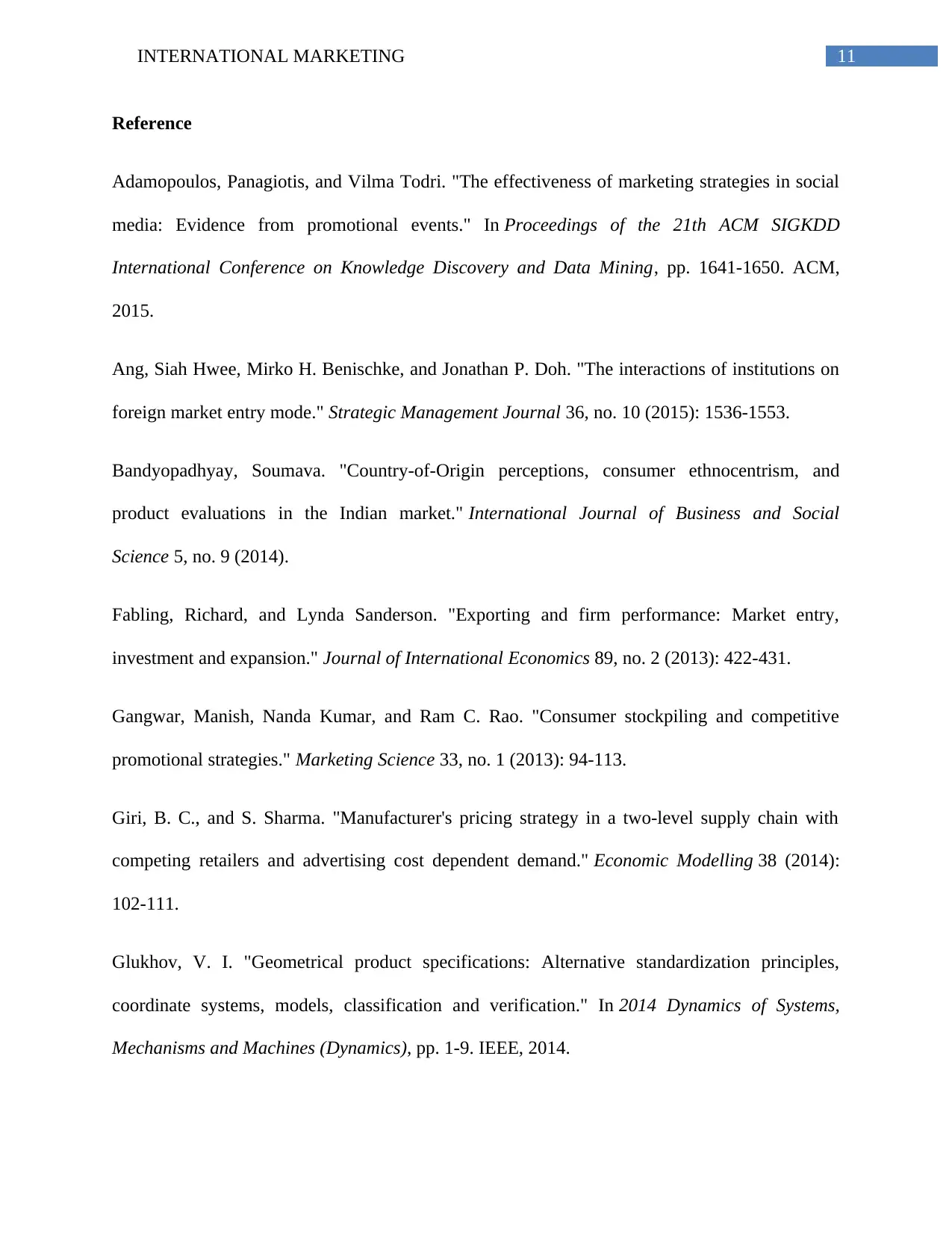
11INTERNATIONAL MARKETING
Reference
Adamopoulos, Panagiotis, and Vilma Todri. "The effectiveness of marketing strategies in social
media: Evidence from promotional events." In Proceedings of the 21th ACM SIGKDD
International Conference on Knowledge Discovery and Data Mining, pp. 1641-1650. ACM,
2015.
Ang, Siah Hwee, Mirko H. Benischke, and Jonathan P. Doh. "The interactions of institutions on
foreign market entry mode." Strategic Management Journal 36, no. 10 (2015): 1536-1553.
Bandyopadhyay, Soumava. "Country-of-Origin perceptions, consumer ethnocentrism, and
product evaluations in the Indian market." International Journal of Business and Social
Science 5, no. 9 (2014).
Fabling, Richard, and Lynda Sanderson. "Exporting and firm performance: Market entry,
investment and expansion." Journal of International Economics 89, no. 2 (2013): 422-431.
Gangwar, Manish, Nanda Kumar, and Ram C. Rao. "Consumer stockpiling and competitive
promotional strategies." Marketing Science 33, no. 1 (2013): 94-113.
Giri, B. C., and S. Sharma. "Manufacturer's pricing strategy in a two-level supply chain with
competing retailers and advertising cost dependent demand." Economic Modelling 38 (2014):
102-111.
Glukhov, V. I. "Geometrical product specifications: Alternative standardization principles,
coordinate systems, models, classification and verification." In 2014 Dynamics of Systems,
Mechanisms and Machines (Dynamics), pp. 1-9. IEEE, 2014.
Reference
Adamopoulos, Panagiotis, and Vilma Todri. "The effectiveness of marketing strategies in social
media: Evidence from promotional events." In Proceedings of the 21th ACM SIGKDD
International Conference on Knowledge Discovery and Data Mining, pp. 1641-1650. ACM,
2015.
Ang, Siah Hwee, Mirko H. Benischke, and Jonathan P. Doh. "The interactions of institutions on
foreign market entry mode." Strategic Management Journal 36, no. 10 (2015): 1536-1553.
Bandyopadhyay, Soumava. "Country-of-Origin perceptions, consumer ethnocentrism, and
product evaluations in the Indian market." International Journal of Business and Social
Science 5, no. 9 (2014).
Fabling, Richard, and Lynda Sanderson. "Exporting and firm performance: Market entry,
investment and expansion." Journal of International Economics 89, no. 2 (2013): 422-431.
Gangwar, Manish, Nanda Kumar, and Ram C. Rao. "Consumer stockpiling and competitive
promotional strategies." Marketing Science 33, no. 1 (2013): 94-113.
Giri, B. C., and S. Sharma. "Manufacturer's pricing strategy in a two-level supply chain with
competing retailers and advertising cost dependent demand." Economic Modelling 38 (2014):
102-111.
Glukhov, V. I. "Geometrical product specifications: Alternative standardization principles,
coordinate systems, models, classification and verification." In 2014 Dynamics of Systems,
Mechanisms and Machines (Dynamics), pp. 1-9. IEEE, 2014.
⊘ This is a preview!⊘
Do you want full access?
Subscribe today to unlock all pages.

Trusted by 1+ million students worldwide
1 out of 14
Related Documents
Your All-in-One AI-Powered Toolkit for Academic Success.
+13062052269
info@desklib.com
Available 24*7 on WhatsApp / Email
![[object Object]](/_next/static/media/star-bottom.7253800d.svg)
Unlock your academic potential
Copyright © 2020–2025 A2Z Services. All Rights Reserved. Developed and managed by ZUCOL.





